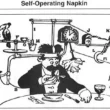In the middle of last week, a previously unknown professor in Switzerland published a report that purported to show that the SEC’s emergency order preventing naked short selling in 19 financial companies had been a mistake. By the end of Friday, that report had become the basis for stories by reporters at the Wall Street Journal, the Financial Times, the Economist, TheDeal.com, Dow Jones Newswires, Reuters, and Hedgeworld.
So much for the notion that our financial media is comprised of independent thinkers, all busily analyzing data and asking probing questions in the sacred pursuit of “truth.” Far easier to copy straight from the press release (or, more likely, the email sent around by some short-seller or lobbyist).
“The 19 stocks lost 3.83 percent of value…compared with their peers,” reported the Financial Times.
“The…shares affected by the order lost about 3.8 percent of their value, compared to their peers,” reported Reuters.
“Shares covered by the order lost 3.8% of their value compared with their peers,” reported Dow Jones Newswires.
“Shares covered by the order lost 3.8% of their value compared with their peers,” reported the Wall Street Journal, which merely reprinted the Dow Jones story.
That this phrase was circulated with such precision is all the more remarkable considering that it makes absolutely no sense. “Compared to their peers”? What does that mean? If I have a hundred bucks, I cannot lose $3.80, “compared to my peers.” Either I lose the $3.80, or I do not.
Aside from being gobbledygook, the phrase is grossly misleading. The 19 shares covered by the emergency order did not lose value. To the contrary, their prices rose dramatically from the day that the order was announced until its expiration (at which point prices plunged).
Yet, to drive home the misperception, the Wall Street Journal’s headline reads: “Stocks Under ‘Short’ Order Fell During Protection Period.”
Reuters reported that “many of the 19 stocks…suffered declines in their share prices.”
The Financial Times proclaimed that the emergency order “had contributed to a decline in the [19 companies’] share prices.”
All according to the professor in Switzerland. But clearly, these reporters did not read the report by the professor in Switzerland. If they had, they would have known that the professor, who is named Arturo, did not claim that the 19 stocks’ prices had fallen. He said only that their “abnormal returns” during the period of the emergency order were 3.8% (or 10%, according to a follow-up report) less than the “abnormal returns” of “their peers” — a sample of 59 financial stocks that weren’t subject to the SEC’s order.
An “abnormal return” is the difference between expected returns (based on previous performance of the stocks and overall performance of the market) and actual returns. It is highly debatable whether it makes sense to look at abnormal returns (as opposed to plain old prices), but even supposing they are relevant, Professor Arturo’s numbers (if not his misleading language) suggest that the SEC’s emergency order profoundly improved the performance of those 19 stocks.
The professor analyzes only one time period prior to the emergency order: June 1 to July 14. He finds that over this period, cumulative abnormal returns for the 19 stocks were negative 12.34%. From July 15, when the order was announced, to July 20, cumulative abnormal returns were positive 12.42%. From the time that the order actually went into effect on July 20 to August 8 (the last day for which professor Arturo provides data), the abnormal returns were negative 4.57%, still a lot better than the period prior to the emergency order.
Meanwhile, according to the report, the 59 financial stocks that were not directly affected by the order got an even bigger boost. Their cumulative abnormal returns were negative 10.82% over the pre-emergency order period of June 1 to July 14, and positive 5.68% over the July 20-August 8 period when the emergency order was in place.
It might seem paradoxical that unprotected stocks were helped more than the protected stocks, but it is not really surprising when you consider that illegal naked short selling of many of those 59 companies was far more prevalent than in the cases of the privileged 19. Perhaps criminal naked short sellers, guessing that the SEC might extend its protections across the market, began borrowing real shares or decreasing their short positions in all the companies they were attacking. The stocks that had been under the heaviest naked short attacks saw the biggest gains.
The fact that the abnormal returns of the 19 protected stocks were 3.8% lower than the abnormal returns of other stocks is otherwise meaningless. Investors might rather buy the stocks with higher returns, and in that sense the 59 unprotected stocks are more valuable. But this does not mean that the 19 protected stocks “lost value” during the emergency order. It does not mean that their returns (abnormal or otherwise) worsened. It certainly does not mean that their “prices declined.” Not “compared to their peers.” Not any other way.
Normally, I would be inclined to sympathize with the journalists. Financial statistics are a little bit complicated. Deadlines are tight. And never in history have journalists been more overworked. Often, reporters just don’t have time to do the research, or crunch the numbers themselves.
But the problem here is not just that journalists misread, or chose not to read, a report about a complex issue. No, what horrifies is that an entire pack of journalists failed to make the simplest of all calculations. They failed to compute the difference between good and bad.
Illegal naked short selling is one of the biggest financial swindles of our lifetimes. That is bad.
The SEC took a small step towards preventing this crime. That is good.
Rather than demand that the SEC take a bigger step to protect all of the hundreds of companies affected by illegal naked short selling, a bunch of important financial journalists published a slew of nearly identical stories suggesting that the SEC shouldn’t have acted at all — and their only excuse for writing these stories was that somebody sent them an email misrepresenting a skewed report by some guy in Switzerland named Arturo.
That is bad. Really bad.



